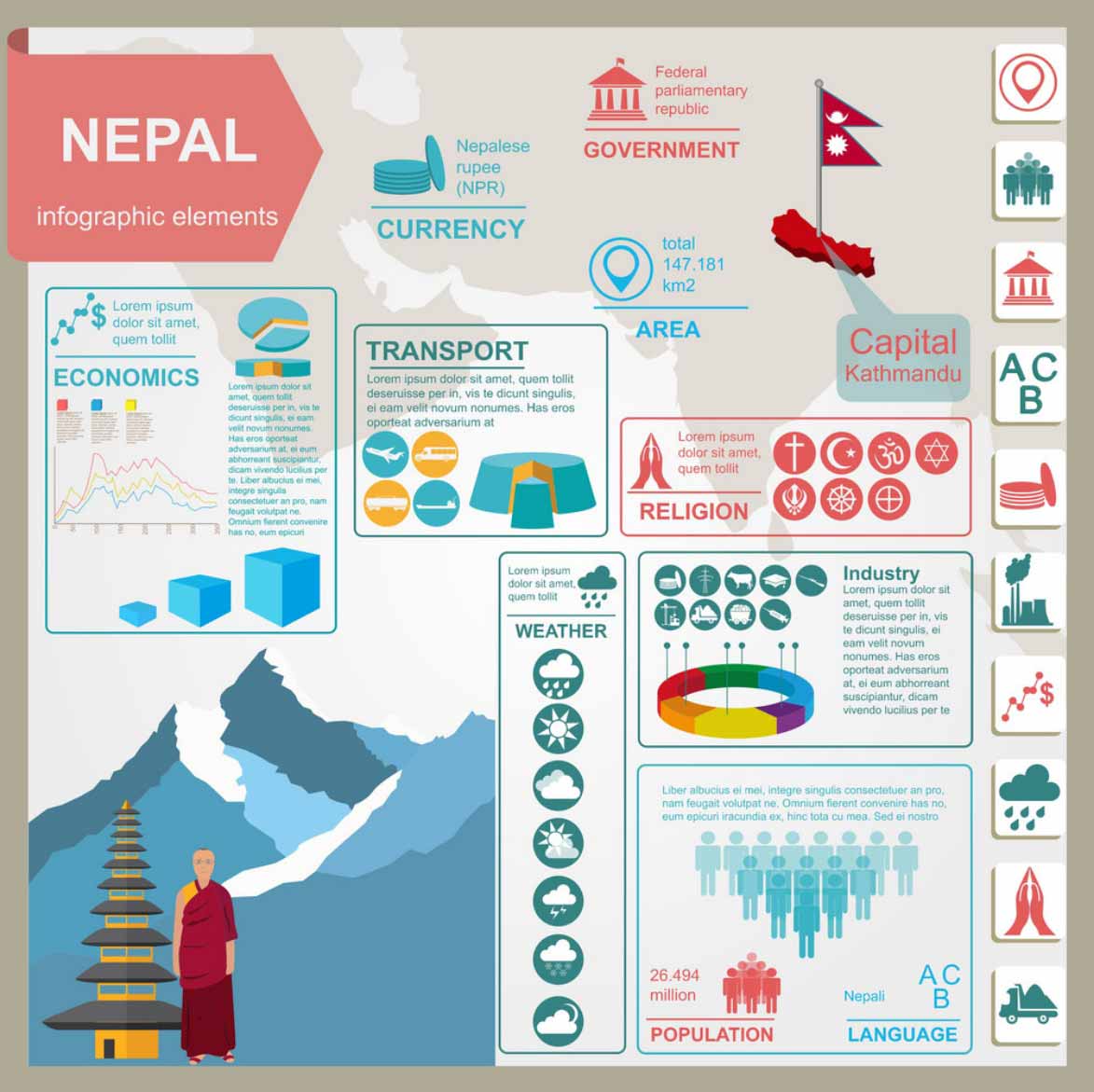Lumbini Province: A Data Overview
A comprehensive data journal with an objective to
make data free for everyone collected and
compiled in one single address. Explore with us.
Lumbini Province

Geography
Lumbini Province lies in the mid western part of the country. It has an area of 22,288sq.km and that is 15.11% of the total area of the country. 45% of provincial land is covered by forest including Banke and Bardia National Parks and some parts of Dhorpatan hunting reserve. 29% land is arable and 14% of the Province land is utilized for housing purpose. It is bordered by India in the south, Putha himal of Rukum East in the north and Rampur of Palpa district in the east to Rajapur of Bardia district in the west.
Topographically, the province can be divided into five main regions starting from the North, viz. 1) High Himalayas (3.1%), 2) High Mountains (9.1%), 3) Middle Mountains (32.2%), Siwalik region (27.9%) and 4) Terai region (27.6%).
43.3 percent provincial land is at an altitude of less than 500 meters. This area is mostly covered by fertile land and dense forest. 20.4 percent of area is at an altitude of 500-1000 meters. 24.2 percent land is at an altitude of 1000 to 2000meters. Similarly 7.4 percent land is at an altitude of 2000 to 3000 meters and land above 3000 meters altitude is 4.9 percent.
Apart from the topographical divisions, administratively there are 12 Districts. As per the new constitutional provision there are 109 local governments composed of 4 sub-metropolitan cities, 32 municipalities and 73 rural-municipalities with 983 wards.
Social and Cultural Diversity
Total population of the province is 4499272. Out of total population 51.68% of the provincial population is residing in the urban area. The largest ethnic group is Tharu (15.2%). Similarly, there are 15.1% Magar, 13.8% Chettri, 12.5% Brahman (Hill), and 6.9% Muslim.
Economy
As per Economic Survey (2019/20), Lumbini Province contributes 14% to national GDP. Measuring GDP by provinces it is estimated to have a growth rate of 2.0% in the fiscal year 2019/20.
There are 614 commercial banks, 307 development banks, 34 finance companies, 900 Microfinance companies. Similarly, there are 272 life and 190 non life insurance companies and their branches in the province.
Agriculture, forest and tourism are the mainstay of province economy. Productivity of paddy in the province is 3.91 MT per ha, which is above the national average productivity of 3.8MT per ha (CBS; Rice production estimate for fiscal year 2018/19). Out of the total paddy production in the country Lumbini Province comprises 21.4%. Similarly 24.7% of Wheat and 13.9% Maize is produced in the province.
316000 ha of agriculture land are irrigated through 541 irrigation systems in the province. Similarly, there are various irrigation projects under construction, namely, Bheri Babai diversion, Babai, Sikta. After completion all these big irrigation projects will irrigate approximately 140000 ha of land.
There are 522 industries registered under department of industry. Out of total number of industries Production based industry shares the highest number i.e. 418. While there are only 24 Agriculture and forestry based industry.
There are 14715 companies registered under company act in the province. Similarly, 68334 small, cottage and micro level industries are registered in the province. These industries create an estimated 477654 employment.
Lumbini Province has seen a considerable growth in electrification. According to Nepal Electricity Authority report 91% household in the province are electrified. Total number of electricity consumers in the province is 457992, consuming 370.8 Million MWh of energy annually. According to NEA, Distribution and Consumer Service Directorate 93% of consumers are domestic users; loss of electricity in the province is 12.17% for the year 2076/77. Out of the total loss in distribution provincial office, Gularia contributes the highest loss percentage of 25.02% (2076/77).
8931 km of road is constructed in the Province. Out of which 5293 km is blacktopped.
There are 5707 schools in the province with 1255141 students including 621735 girls and 633406 boys. All together there are 23627 teachers (temporary and permanent) working in various levels of schools.
There are 20 government hospitals, 30 primary health care centers, 570 health posts and 363 birthing centers in the province.
Policy and Programmes for fiscal year 2078/79
Province Overview
| Indicators | Value |
|---|---|
| Geography | |
| Area (sq.km) | 22288 |
| Capital | Butwal |
| Administrative Division | |
| Districts | 14 |
| Metropolitan City | 0 |
| Sub-Metropolitan City | 4 |
| Municipality | 32 |
| Gaun Palika | 73 |
| Total No. of Wards | 983 |
| Voters (2074) | |
| Total | 2461514 |
| Male | 1236472 |
| Female | 1225019 |
| TG | 23 |
| Constituenties | 26 |
| Demography | |
| Population (2011) | 4499272 |
| Male | 2140316 |
| Female | 2358956 |
| Sex Ratio (M/F) | 80 |
| Total Household | 885203 |
| Average Household Size | 4.531 |
| Population Density (persons/sq.km) | 207.69 |
| Population by Type of Local Unit | |
| Metropolitan City | 0 |
| Sub-Metropolitan City | 575385 |
| Municipality | 1740672 |
| Gaun Palika | 2140128 |
| note: percentage as of total population of the province | |
| Under 14 Population (%) | 36.3 |
| Population 15-59 yrs (%) | 55.8 |
| Elderly Population 60+ (%) | 7.9 |
| Annual Growth Rate (%) | |
| Household by Ownership of House (2011) | |
| Own | 827223 |
| Rented | 75787 |
| Household using wood/firewood as type of cooking fuel | 669567 |
| Household using Electricity as type of cooking fuel | 23640 |
| Household with access to safe drinking water* | 434811 |
| Household with access to Toilet Facilities | 516076 |
| Household without access to Toilet Facilities | 394412 |
| Household with access to Internet | 11851 |
| Household with access to Mobile Phone | 591305 |
| Household with access to Radio | 470333 |
| Household with access to Television | 249589 |
| Household with access to Electricity for lighting | 586685 |
| Household by Type of Foundation of House | |
| Household with Mud bonded bricks/stone as foundation of house | 557418 |
| Household with Cement bonded bricks/ stone as type of foundation of house | 135952 |
| RCC with pillar | 59622 |
| Wooden pillar | 121894 |
| Household with Female ownership in | |
| Both house & land | 97513 |
| Land only | 72372 |
| Neither house nor land | 739504 |
| Socio-Economic Indicators | |
| Literacy (%) (NMICS 2019) | |
| Total | |
| Male | |
| Female | |
| Number of Schools (Public) 2018/19 | |
| L_Basic | 4564 |
| U_Basic | 1854 |
| Basic | 4584 |
| Secondary | 1023 |
| Higher Secondary | 431 |
| Number of Schools (Private) | |
| L_Basic | 1074 |
| U_Basic | 706 |
| Basic | 1074 |
| Secondary | 514 |
| Higher Secondary | 146 |
| Number of Students (Public) | |
| L_Basic | 513835 |
| U_Basic | 258930 |
| Basic | |
| Secondary | 141297 |
| Higher Secondary | 98796 |
| Number of Students (Private) | |
| L_Basic | 184473 |
| U_Basic | 77716 |
| Basic | |
| Secondary | 37404 |
| Higher Secondary | 16744 |
| NER 2018/19 | |
| L-Basic | 96.8 |
| U_Basic | 86 |
| Basic | 91.4 |
| Secondary | 63.7 |
| Higher Secondary | 22 |
| Agriculture (FY 017/18) | |
| Production of Major Cereal Crops (MT)2017/18 | |
| Paddy | 1120131 |
| Maize | 355081 |
| Wheat | 484582 |
| Production of Major Cash Crops (MT) 2017/18 | |
| Oil Seed | 62408 |
| Potato | 311984 |
| Sugarcane | 465807 |
| Production of Pulses | 110788 |
| Production of Spices | 62409 |
| Production of Vegetables (MT) | 556991 |
| Productio of Milk (MT) | 367876 |
| Production Eggs in number (000) | 169818 |
| Production of Fish (Kg) | 11777738.83 |
| Meat Production (MT) | 63185 |
| Production of Wool (MT) | 97002 |
| Production of Fruits (MT) | |
| Citrus Fruits# | 25934.710757 |
| Winter Fruits** | 8073.83445 |
| Summer Fruits*** | 106013.22229273 |
| Annual Sales of Chemical Fertilizers (017/18) | 84548.155 |
| Health Service**** | |
| Number of Hospitals | 19 |
| Primary health care center (PHCC) | 31 |
| Health Care Centers | 570 |
| Female Health Care Volunteer | 8718 |
| Road Connectivity | |
| Total Road Length## (Km) | 2450.02 |
| Population Influenced per Km of Road | 22183 |
| Road Density (Km/100 sq.km) | 159 |
Local Governments in Data
| Municipalities | District | Area (sq km) | Population | Schools | Hospitals | Details |
|---|---|---|---|---|---|---|
| Bhumikasthan Municipality | Arghakhanchi | 159.13 | 32640 | 66 | - | View More |
| Sandhikharka Municipality | Arghakhanchi | 129.42 | 41079 | 79 | 1 | |
| Shitaganga Municipality | Arghakhanchi | 610.43 | 43373 | 115 | - | |
| Kohalpur Municipality | Banke | 184.26 | 70647 | 57 | - | |
| Nepalgunj Sub Metropolitian City | Banke | 85.94 | 138951 | 148 | 3 | |
| Bansgadhi Municipality | Bardia | 206.08 | 55875 | 60 | - | |
| Barbardiya Municipality | Bardia | 226.09 | 68012 | 57 | - | |
| Gulariya Municipality | Bardia | 118.21 | 66679 | 55 | 1 | |
| Madhuwan Municipality | Bardia | 129.73 | 46437 | 42 | - | |
| Rajapur Municipality | Bardia | 127.08 | 59553 | 51 | - | |
| Thakurbaba Municipality | Bardia | 104.57 | 44316 | 48 | - | |
| Ghorahi Sub Metropolitian City | Dang | 522.21 | 156164 | 174 | 1 | |
| Lamahi Municipality | Dang | 326.66 | 47655 | 47 | 1 | |
| Tulsipur Sub Metropolitian City | Dang | 384.63 | 141528 | 159 | 1 | |
| Musikot Municipality | Gulmi | 114.74 | 32802 | 68 | - | |
| Resunga Municipality | Gulmi | 83.74 | 32548 | 58 | 1 | |
| Banganga Municipality | Kapilbastu | 233.68 | 75242 | 69 | 1 | |
| Buddhabhumi Municipality | Kapilbastu | 366.67 | 64949 | 69 | - | |
| Kapilvastu Municipality | Kapilbastu | 126.91 | 76394 | 72 | 1 | |
| Krishnanagar Municipality | Kapilbastu | 96.66 | 62360 | 55 | 1 | |
| Maharajgunj Municipality | Kapilbastu | 112.21 | 54800 | 72 | - | |
| Shivraj Municipality | Kapilbastu | 284.07 | 66781 | 73 | - | |
| Bardghat Municipality | Nawalparasi West | 162.05 | 61472 | 62 | 1 | |
| Ramgram Municipality | Nawalparasi West | 128.32 | 56845 | 59 | 1 | |
| Sunwal Municipality | Nawalparasi West | 139.1 | 55790 | 54 | - | |
| Rampur Municipality | Palpa | 123.34 | 35396 | 60 | 1 | |
| Tansen Municipality | Palpa | 109.8 | 50405 | 77 | 1 | |
| Pyuthan Municipality | Pyuthan | 128.96 | 38449 | 62 | 1 | |
| Swargadwari Municipality | Pyuthan | 224.7 | 30940 | 63 | - | |
| Rolpa Municipality | Rolpa | 270.42 | 32759 | 73 | 1 | |
| Butwal Sub Metropolitian City | Rupandehi | 101.61 | 138742 | 104 | 1 | |
| Devdaha Municipality | Rupandehi | 136.95 | 53523 | 50 | - | |
| Lumbini Sanskritik Municipality | Rupandehi | 112.21 | 72497 | 75 | - | |
| Sainamaina Municipality | Rupandehi | 162.18 | 55822 | 33 | - | |
| Siddharthanagar Municipality | Rupandehi | 36.03 | 63483 | 70 | 1 | |
| Tilottama Municipality | Rupandehi | 126.19 | 100149 | 85 | - |
Human Development Index (HDI)
Population under absolute poverty (%)
Literacy Rate (age 15-24) (%)
Per Capita Income (USD) at base price 2068
Human Poverty Index
Sector-wise Data Overview of Lumbini Province
Fast Facts of Lumbini Province
Nepal Outlook compiles key indicators based upon recently updated research and survey documents published and endorsed by Central Bureau of Statistics, Nepal Government in a most easiest and clear format.
We also help you get any data, report and research materials upon request at a minimum service charge.
885203
Total Household
46.9%
Household with Access to Internet
4499272
Total Population
90.8%
Popn with Access to Electricity
2325057
33.7%
Child Marriage Before 18 (women)
404541
Arable Land (ha)
93.2%
Ownership of Mobile Phone
11.2%
Unemployment
485633
Electricity Consumers
76.7%
Birth Registration
8931
Local Roads Network (km)
Data Leader, 21 Years in a Row
Focusing on various sectors related to development of the country, our team has been actively involved in disseminating information about districts since 1999 AD through various editions of Data Profile’s namely District Development Profile of Nepal (2001), District Demographic Profile of Nepal (2002), District Development Profile of Nepal (2004), National Policies of Nepal, Development Profile of Nepal (2008) & Energy Outlook of Nepal (2011).


The Right Choice
Share us your contact details to discuss on how we can work together on your research and study projects. We come and discuss your problem statements and provide expert consulting to derive right process and solution for your business.
